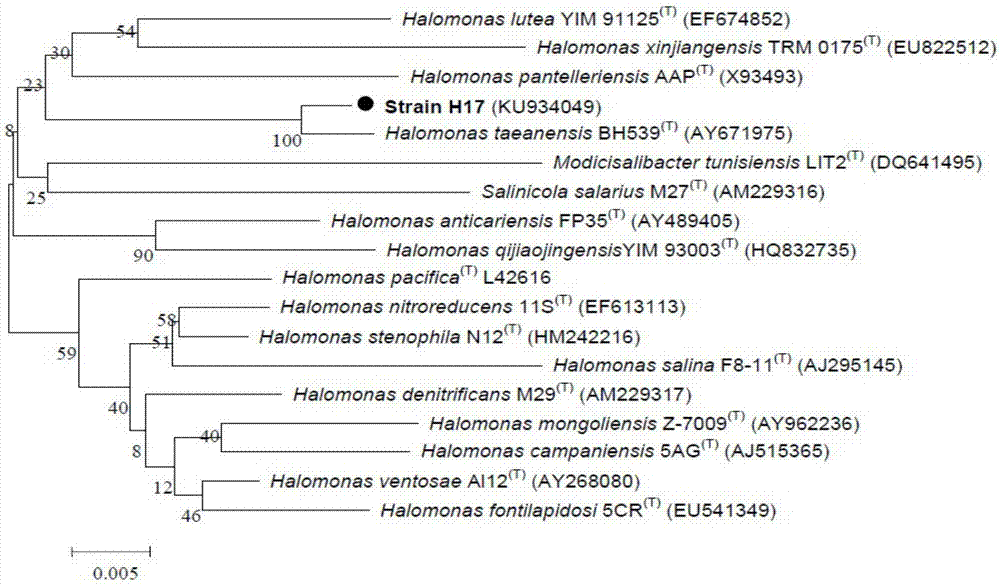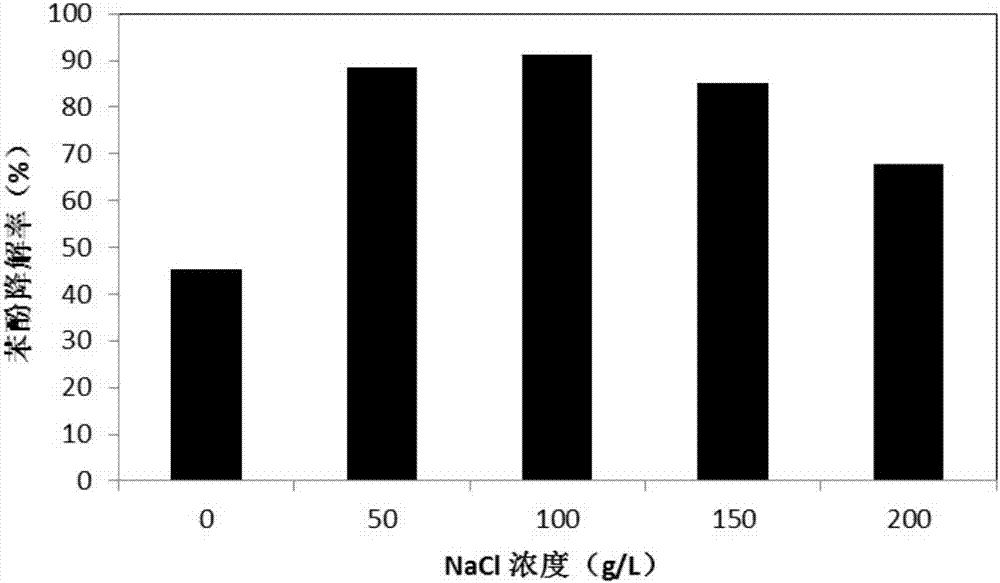Halomonas taeanensis for degradation of phenol
A Halomonas, phenol technology, applied in the direction of bacteria, microorganism-based methods, water/sludge/sewage treatment, etc., to achieve good salt resistance effect, good economic value and application prospects
- Summary
- Abstract
- Description
- Claims
- Application Information
AI Technical Summary
Problems solved by technology
Method used
Image
Examples
Embodiment 1
[0023] The isolation and identification of embodiment 1 Halomonas H17
[0024] 1. Isolation of Halomonas H17
[0025] a. Dissolve 1-5g of collected solid samples (salt lake sludge, submarine sludge, high-salt wastewater treatment sludge, etc.) or 500ml of liquid samples (salt lake water, seawater, high-salt wastewater, etc.) in 10-50ml Liquid medium (10g MgSO 4 ·7H 2 O, 0.2g CaCl 2 2H 2 O, 2-5g KCl, 2.5g tryptone, 10g yeast extract, NaCl15%, distilled water were added to 1000ml. Adjust the pH to about 7.2, sterilize at 121°C for 15 minutes), shake at 80-160 rpm for 30-120 minutes at room temperature, take it out and let it stand for 20-40 minutes, draw 100 μL with a pipette, and spread evenly on the solid medium for culture Place on a flat plate (obtained by adding 2% agar to the above-mentioned liquid medium), and place it in a constant temperature incubator at 28°C for static culture.
[0026] b. When visible colonies are grown, use an inoculation loop to pick a single...
Embodiment 2
[0036] The performance test of the degradation phenol of embodiment 2 Halomonas H17
[0037] The degradation of phenol in the medium by Halomonas H17 was detected by high performance liquid chromatography.
[0038] 1. Growth of strain H17 and characteristics of phenol degradation
[0039] Bacterial strain H17 is 200mg / L in phenol concentration, and the medium that sodium chloride concentration is 10%, the formula of described medium 1L is 10g MgSO 4 ·7H 2 O, 0.2g CaCl 2 2H 2 O, 2-5g KCl, 2.5g tryptone, 10g yeast extract, NaCl10%, distilled water were added to 1000ml. Adjust the pH to about 7.2, and sterilize at 121°C for 15 minutes.
[0040] The curves of strain growth and phenol concentration changes over time in the medium are as follows: figure 2shown. Strain H17 entered the logarithmic growth phase after a stagnation period of about 8 hours. During this period, the strain grew almost linearly with time, and the strain was in a stable growth period near 30 hours and...
PUM
| Property | Measurement | Unit |
|---|---|---|
| diameter | aaaaa | aaaaa |
Abstract
Description
Claims
Application Information
 Login to View More
Login to View More - R&D
- Intellectual Property
- Life Sciences
- Materials
- Tech Scout
- Unparalleled Data Quality
- Higher Quality Content
- 60% Fewer Hallucinations
Browse by: Latest US Patents, China's latest patents, Technical Efficacy Thesaurus, Application Domain, Technology Topic, Popular Technical Reports.
© 2025 PatSnap. All rights reserved.Legal|Privacy policy|Modern Slavery Act Transparency Statement|Sitemap|About US| Contact US: help@patsnap.com



